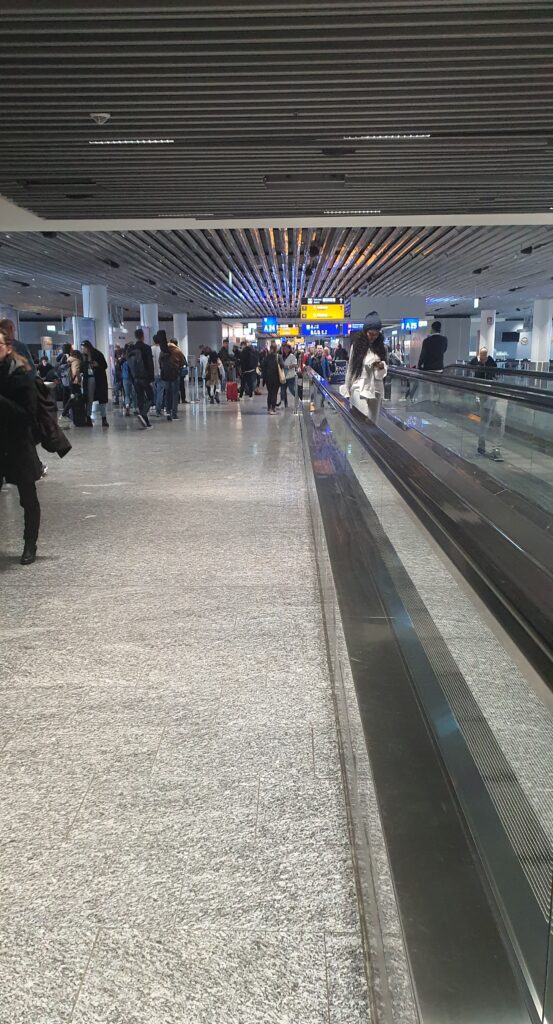
How your airport transit can impact your business success?
Are you a business traveler? What do you see in this photo? Yes, this is the Frankfurt airport, one of the biggest airports of Europe. But what do I see? I see people in a rush, they are on the phone organising the next meeting, stressing if they can make deal and get the contract signed, trying to find their gate, anxious to miss their plane – and they are walking fast on an unnaturally flat, hard and cold surface in the maze of the Frankfurt terminals among other stressed individuals. Many of my clients reported that after a transit in a big airport (Frankfurt, Amsterdam, Singapore, London) their existing locomotion system problems got aggravated or they developed new ones, right before a crucial negotiation or an important presentation. This experience is very common and with my clients, we named it the „Frankfurt airport disease”. Very often, the feet and ankles are reacting the most, but not exclusively: knee, hip, low back, shoulder, neck can be affected as well. But what is this phenomenon? First, we all have stress-related movement patterns that effect the posture, the gait, the muscle tensions. These patterns are enhanced in an environment in which our peers are signalling stress because we tend to mimic other humans’ behavior. Business travelers can experience higher stress if they are working while traveling (and this is a very common scenario). On the other hand, our body is designed to move on uneven and reactive surfaces and it is very tricky to walk comfortably on the rigid floor of the airports. On the top of that, after the first flight segment, many passengers can develop the so-called gravitational oedema (swollen ankle and feet) that further reduces the adaptation capacities of the body. Typical business clothing is not providing much protection either. But you deserve to operate at your peak performance in your work, so let’s see some tricks on how to protect your health on a business trip!
What can you do to protect your health?
- Learn your own stress related embodiment patterns and learn how to control them (idea: Stress Management, Health-Performance Balance by Boglarka Simon)
- Spend some minutes in your first flight to practice mindfulness and reduce your muscle tension with progressive relaxation
- Book a foot massage a day before your travel, if the airport has a massage service, book an appointment
- Have comfortable shoes with thick sole – if you can’t bring them because of the size of your cabin luggage, put a spongy insole in your business shoes, have a padding in your heels
- Wear compression socks or tights
- If you have any luggage that you must carry in your hand or on your shoulders, regularly change side to avoid asymmetrical loading
- Use active stress modulation techniques
- Mental preparation for the decision making, especially if you expect to make critical decisions (idea: Efficiency in Critical Decisions by Boglarka Simon)
- Make some exercises in the business lounge or on the chairs of the waiting area: some simple moments will make it, even of you are in suits and heels, you have options
- Slow down your pace of walking and use the elevators and sidewalks
- Use mobility services if you have any relevant locomotion system issues, low back pain, knee problem etc.
- Stay hydrated
- Magnesium and vitamin B12 can help in many situations
Literature
https://www.mayoclinic.org/diseases-conditions/edema/expert-answers/foot-swelling/faq-20057828
Dixon, P. C., Smith, T., Taylor, M. J. D., Jacobs, J. V., Dennerlein, J. T., & Schiffman, J. M. (2019). Effect of walking surface, late-cueing, physiological characteristics of aging, and gait parameters on turn style preference in healthy, older adults. Human movement science, 66, 504-510.
Fulton, J. E., Frederick, G. M., Paul, P., Omura, J. D., Carlson, S. A., & Dorn, J. M. (2017). Increasing walking in the Hartsfield-Jackson Atlanta international airport: the walk to Fly study. American journal of public health, 107(7), 1143-1149.


